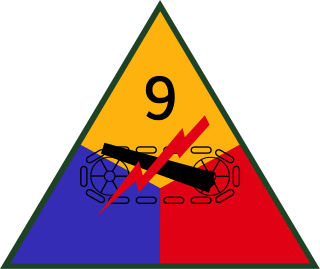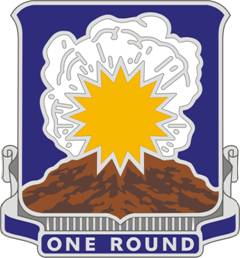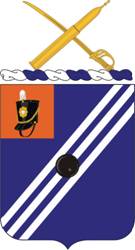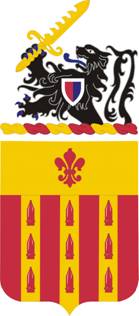Related Research Articles

The 101st Airborne Division is a light infantry division of the United States Army specializing in air assault operations. The Screaming Eagles were referred to as "the tip of the spear" by former U.S. Secretary of Defense Robert Gates and the most potent and tactically mobile of the U.S. Army's divisions by former Chief of Staff of the Army GEN Edward C. Meyer. The 101st Airborne can plan, coordinate, and execute multiple battalion-size air assault operations to seize key terrain and can work in austere environments with limited or degraded infrastructure. These operations can be conducted by mobile teams covering large distances and engaging enemy forces behind enemy lines. Its unique battlefield mobility and high level of training have kept it in the vanguard of U.S. land combat forces in recent conflicts, e.g. foreign internal defense and counterterrorism operations in Iraq and Afghanistan.

The 9th Armored Division was an armored division of the United States Army during World War II. In honor of their World War II service, the 9th was officially nicknamed the "Phantom Division."

The 10th Armored Division was an armored division of the United States Army in World War II. In the European Theater of Operations the 10th Armored Division was part of both the Twelfth United States Army Group and Sixth United States Army Group. Originally assigned to the Third United States Army under General George S. Patton, it saw action with the Seventh United States Army under General Alexander Patch near the conclusion of the war.

The Siege of Bastogne was an engagement in December 1944 between American and German forces at the Belgian town of Bastogne, as part of the larger Battle of the Bulge. The goal of the German offensive was the harbor at Antwerp. In order to reach it before the Allies could regroup and bring their superior air power to bear, German mechanized forces had to seize the roadways through eastern Belgium. Because all seven main roads in the densely wooded Ardennes highlands converged on Bastogne, just a few miles away from the border with neighboring Luxembourg, control of its crossroads was vital to the German attack. The siege was from 20 to 27 December, until the besieged American forces were relieved by elements of General George Patton's Third Army.

The 9th Infantry Division is an inactive infantry division of the United States Army. It was created as the 9th Division during World War I, but never deployed overseas. In later years, it would become an important unit of the U.S. Army during World War II and the Vietnam War. It was also activated as a peacetime readiness unit from 1947 to 1962 at Fort Dix, New Jersey, and Fort Carson, Colorado, and from 1972 to 1991 as an active-duty infantry division at Fort Lewis, Washington. Nicknamed the "Old Reliables", the division was eventually deactivated in December 1991.
The 502nd Infantry Regiment, previously titled the 502nd Parachute Infantry Regiment, is an infantry regiment of the United States Army. The regiment was established shortly after the American entry into World War II, and was assigned as a regiment of the 101st Airborne Division, "The Screaming Eagles", one of the most decorated formations of the U.S. Army. The regiment saw substantial action in the European Theater of World War II and was inactivated in 1945, shortly after the end of the war. Reactivating in a new form in 1956, the 502d Infantry has served in the Vietnam War, the first Gulf War, Operation Iraqi Freedom, Operation Enduring Freedom in Afghanistan, and Operation Inherent Resolve in Iraq. Since 1974, the regiment has been classified as an Air Assault unit. Currently, its 1st and 2nd battalions are active. Both battalions are assigned to the 2nd Brigade Combat Team, 101st Airborne Division.

The 327th Infantry Regiment is an infantry regiment of the 101st Airborne Division of the United States Army. During World War II, the 327th was a glider-borne regiment of the 101st Airborne Division. It fought during World War I as part of the 82nd Division. It has also been deployed in the Vietnam War, Gulf War, and most recently to Iraq and Afghanistan. The song "Glider Rider" describes (humorously) some of the slights that glider-borne troops felt they received from the Army during World War II; though the regiment's public fame rose with the 1949 movie Battleground about the Siege of Bastogne in late 1944.
Pentomic was a structure for infantry and airborne divisions adopted by the US Army in 1957 in response to the perceived threat posed by tactical nuclear weapons use on the battlefield.

The 333rd Field Artillery Battalion was a racially segregated United States Army unit of African-American troops during World War II.

The 705th Tank Destroyer Battalion was a tank destroyer battalion of the United States Army active during the Second World War. It was originally formed from artillery elements of the 5th Armored Division, and its lineage is today perpetuated by the 75th Cavalry Regiment.

The 319th Field Artillery Regiment, more commonly referred to as the 319th Airborne Field Artillery Regiment, is a parent regiment in the U.S. Army Regimental System. Four battalions of the regiment are currently active. The first three battalions 1st Battalion, 319th Field Artillery Regiment, 2nd Battalion, 319th Field Artillery Regiment, 3rd Battalion, 319th Field Artillery Regiment are in the 82nd Airborne Division and the 4th Battalion, 319th Field Artillery Regiment is in the 173rd Airborne Brigade.
The 3rd Field Artillery Regiment is a field artillery regiment of the United States Army, first formed in 1812, although regimental units trace their lineages as far back as 1794. Based on the service of these antecedents, the regiment claims battle honors for the War of 1812, the Seminole campaign, the Mexican War, the Civil War, the Spanish–American War, and the Philippine Insurrection. The regiment served with the 6th Division during World War I, with the 5th Division, 6th Division and 2d Cavalry Division between the world wars, and with the 9th Armored Division during and after World War II. Since 1961, the regiment has been a parent regiment under the Combat Arms Regimental System and the U.S. Army Regimental System, with regimental elements serving with the 1st, 6th, and 8th Infantry Divisions; 2nd and 3rd Armored Divisions; 1st Cavalry Division; 194th Armored Brigade; and various field artillery brigades and groups. Two regimental battalions are currently active: the 2nd Battalion in the 1st Armored Division and the 5th Battalion in the 17th Field Artillery Brigade

The 76th Field Artillery Regiment is a field artillery regiment of the United States Army. First formed as a cavalry regiment in 1916, the regiment was converted to field artillery in 1917, and served in Europe during World War I with the 3rd Division and as a separate battalion during World War II, as well as in peacetime at Fort Knox, KY, and Fort Devens, MA. Since 1959, the regiment has been a parent regiment under the Combat Arms Regimental System and the U.S. Army Regimental System, with regimental elements serving with the 3rd Infantry Division in Germany and Operation Iraqi Freedom, with the 7th Infantry Division in Korea, and in the Army Reserve. No regimental elements are currently active.

The 321st Field Artillery Regiment is a field artillery regiment of the United States Army. A parent regiment under the U.S. Army Regimental System, the 321st FAR currently has one active battalion, the 3rd Battalion, 321st FAR, assigned to the 18th Field Artillery Brigade at Fort Bragg, NC. The battalion is equipped with M142 HIMARS.
The regiment served with the 82nd Division during World War I and with the 101st Airborne Division during World War II. Elements of the regiment have served with the 82nd and 101st Airborne Divisions in Vietnam, and with the 82nd Airborne Division and 18th Field Artillery Brigade during the Global War on Terrorism.
The 377th Field Artillery Regiment is a field artillery regiment of the United States Army. A parent regiment under the U.S. Army Regimental System, the regiment's 2nd Battalion, 377th Field Artillery Regiment is assigned to the 4th Brigade Combat Team, 25th Infantry Division. Elements of the regiment have also served with the 101st Airborne Division and 82nd Airborne Division, and have seen service in World War II, Vietnam, and in both Iraq and Afghanistan during the Global War on Terror. The 1st and 3rd Battalions as well as Batteries D and E are Inactive.

The 333rd Field Artillery Regiment is a regiment of the Field Artillery Branch of the United States Army.

The 2nd Infantry Division Artillery (DIVARTY) or "Warrior Strike" is the Force Field Artillery Headquarters for the 2nd Infantry Division. The DIVARTY served with the division from 1917 to present, including combat service in World War I, World War II, and the Korean War. In addition to peacetime service with the division at Fort Lewis, Washington, Fort Benning, Georgia, and in Japan and Alaska, the DIVARTY spent 40 years in Korea. After seven years stationed at Joint Base Lewis McChord, where the DIVARTY provides fire support coordination and mission command for the training and readiness of five field artillery battalions, the Army restationed the DIVARTY to Camp Humphreys on 16 September 2021.

The 1st Battalion, 321st Field Artillery Regiment is an inactive field artillery battalion of the United States Army. The battalion served in World War I, World War II, Vietnam and the Global War on Terror with the 82nd Airborne and 101st Airborne Divisions, and with the 18th Field Artillery Brigade. The battalion was officially inactivated in March 2014, and its firing batteries were distributed throughout the 82nd Airborne Division.

The 101st Airborne Division Artillery (DIVARTY) is the force fires headquarters for the 101st Airborne Division at Fort Campbell, Kentucky. The DIVARTY has served with the division in World War II, Vietnam, Operations Desert Shield and Storm, Operation Iraqi Freedom, and in peacetime at Camp Breckinridge and Fort Campbell, Kentucky, and Fort Jackson, South Carolina. The DIVARTY was inactivated in 2005 as part of transformation to modular brigade combat teams, but was reactivated on 16 October 2014 to provide fire support coordination and mission command for the training and readiness of field artillery units across the division.
The 101st Airborne Division is a specialized modular light infantry division of the US Army trained for air assault operations. The Screaming Eagles has been referred to by journalists as "the tip of the spear" as well as one of the most potent and tactically mobile of the U.S. Army's divisions. The 101st Airborne Division has a history that is nearly a century long. During World War II, it was renowned for its role in Operation Overlord, Operation Market Garden, the liberation of the Netherlands and its action during the Battle of the Bulge around the city of Bastogne, Belgium. During the Vietnam War, the 101st Airborne Division fought in several major campaigns and battles, including the Battle of Hamburger Hill in May 1969. In mid-1968, it was reorganized and redesignated as an airmobile division and then in 1974 as an air assault division. In recent years, the division has served in Iraq and Afghanistan. At the height of the War on Terror, the 101st Airborne Division had over 200 aircraft. The division now has slightly over 100 aircraft.
References
- 1 2 3 4 5 "Archived copy". Archived from the original on 24 October 2020. Retrieved 11 May 2017.CS1 maint: archived copy as title (link)
- 1 2 "Black Soldiers of the Ardennes :: World War II :: Ardennes :: Lest We Forget".
- ↑ Burgett, Donald R. (2002). Beyond the Rhine: A Screaming Eagle in Germany . Dell. ISBN 9780440236368 . Retrieved 29 April 2013.
- 1 2 3 "Chapter XXI: Artillery And Armored Units in the ETO". www.history.army.mil. Archived from the original on 24 October 2020. Retrieved 15 May 2017.
- ↑ "Black Soldiers of the Ardennes :: World War II :: Ardennes :: Lest We Forget". lestweforget.hamptonu.edu. Retrieved 16 May 2017.
- ↑ "WERETH History". www.wereth.org. Retrieved 17 May 2017.